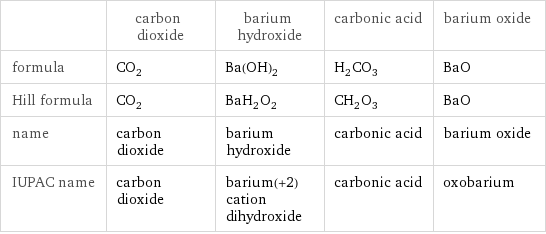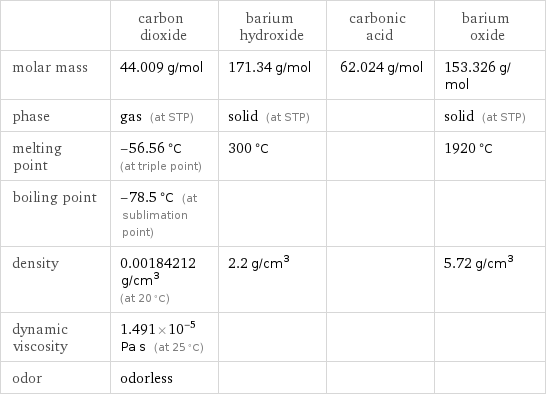Input interpretation

CO_2 (carbon dioxide) + Ba(OH)_2 (barium hydroxide) ⟶ H_2CO_3 (carbonic acid) + BaO (barium oxide)
Balanced equation

Balance the chemical equation algebraically: CO_2 + Ba(OH)_2 ⟶ H_2CO_3 + BaO Add stoichiometric coefficients, c_i, to the reactants and products: c_1 CO_2 + c_2 Ba(OH)_2 ⟶ c_3 H_2CO_3 + c_4 BaO Set the number of atoms in the reactants equal to the number of atoms in the products for C, O, Ba and H: C: | c_1 = c_3 O: | 2 c_1 + 2 c_2 = 3 c_3 + c_4 Ba: | c_2 = c_4 H: | 2 c_2 = 2 c_3 Since the coefficients are relative quantities and underdetermined, choose a coefficient to set arbitrarily. To keep the coefficients small, the arbitrary value is ordinarily one. For instance, set c_1 = 1 and solve the system of equations for the remaining coefficients: c_1 = 1 c_2 = 1 c_3 = 1 c_4 = 1 Substitute the coefficients into the chemical reaction to obtain the balanced equation: Answer: | | CO_2 + Ba(OH)_2 ⟶ H_2CO_3 + BaO
Structures

+ ⟶ +
Names

carbon dioxide + barium hydroxide ⟶ carbonic acid + barium oxide
Equilibrium constant
![K_c = ([H2CO3] [BaO])/([CO2] [Ba(OH)2])](../image_source/d69bc5345179b8f6c7c6114286374dd2.png)
K_c = ([H2CO3] [BaO])/([CO2] [Ba(OH)2])
Rate of reaction
![rate = -(Δ[CO2])/(Δt) = -(Δ[Ba(OH)2])/(Δt) = (Δ[H2CO3])/(Δt) = (Δ[BaO])/(Δt) (assuming constant volume and no accumulation of intermediates or side products)](../image_source/a25d419f89ff5aefcc0bd35c6b72e181.png)
rate = -(Δ[CO2])/(Δt) = -(Δ[Ba(OH)2])/(Δt) = (Δ[H2CO3])/(Δt) = (Δ[BaO])/(Δt) (assuming constant volume and no accumulation of intermediates or side products)
Chemical names and formulas

| carbon dioxide | barium hydroxide | carbonic acid | barium oxide formula | CO_2 | Ba(OH)_2 | H_2CO_3 | BaO Hill formula | CO_2 | BaH_2O_2 | CH_2O_3 | BaO name | carbon dioxide | barium hydroxide | carbonic acid | barium oxide IUPAC name | carbon dioxide | barium(+2) cation dihydroxide | carbonic acid | oxobarium
Substance properties

| carbon dioxide | barium hydroxide | carbonic acid | barium oxide molar mass | 44.009 g/mol | 171.34 g/mol | 62.024 g/mol | 153.326 g/mol phase | gas (at STP) | solid (at STP) | | solid (at STP) melting point | -56.56 °C (at triple point) | 300 °C | | 1920 °C boiling point | -78.5 °C (at sublimation point) | | | density | 0.00184212 g/cm^3 (at 20 °C) | 2.2 g/cm^3 | | 5.72 g/cm^3 dynamic viscosity | 1.491×10^-5 Pa s (at 25 °C) | | | odor | odorless | | |
Units
